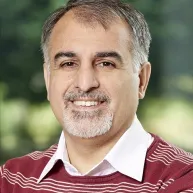Nanoelectronics
Group leader
Specific themes and goals
- Organic solar cells characterization and modeling: In recent years, there have been impressive breakthroughs to enhance the structure of organic solar cells (OSCs) in order to improve the performance. The power conversion efficiency of polymer solar cells has increased from 3% in 2001 to 18.2% in 2021, and these thin, flexible, ecofriendly and low-cost photovoltaic devices are promising for a wide range of applications, such as the Internet of Things, sensors and wearable electronics. Theoretical analyses and characterizations of OSCs are of great scientific and economic value. We have undertaken valuable work in this area, with our results published in several high-impact journals.
- Thin-film microwave, mm-wave and THz devices: Flexible and non-flexible thin-film electronic components are key to improving people’s quality of life. Such devices can be used on infrastructure, vehicles and the human body for control, monitoring and energy harvesting purposes. They can also be cheap to make. For example, flexible substrates, such as plastic, are cheaper compared to crystal wafers like silicon wafers. Thin-film sensors and energy harvesters are two important building blocks of electronic circuits and systems, and these are interesting topics of future research, complementing our expertise. In addition, we are very eager to work on low cost wireless sensors or antennas for medical and Internet of Things (IoT) applications.
- Electromagnetic shielding: In the field of electromagnetic compatibility (EMC), shielding is becoming an increasingly important topic, as our technology and circuitry becomes more sensitive and sophisticated. However, shielding requires air ventilation, input/ outputs and other means of connections between either side of the shields, and these gaps cause emission leakage and degraded shields. Recently, our research group has undertaken successful shielding analyses and measurement of metal enclosures with apertures on different walls. We developed a method of calculating shielding effectiveness (SE) with respect to a metallic enclosure with arbitrary shape apertures on different walls. With our method, there is no need for antennas and reverberation chambers.
- Hetero-integration and packaging of microwave and optical devices: This area of research consists of three parts. The first technological part focuses on implementing techniques in micro and nano electro-mechanical systems techniques. The goal is to integrate high power µ-wave or optical devices based on different materials into a single substrate. The second part deals with the electrical, optical, electro-thermal, and electro-thermo-mechanical modeling and simulation of new packaging structures; the third part concentrates on characterizing and measuring integrated devices, as well as an investigation of packaging environmental effects on their electrical and optical behaviors.
- Flexible electronics especially high frequency flexible devices and circuits: Although electronic circuits are often firm and rigid, some may need to be bent to fit into a particular product while some others may need to undergo continuous flexing if they are moving parts. Specifying the flexible circuit materials and characterizing them for microwave and mm-wave applications are vital for their development. Therefore, we are investigating the flexibility and mechanical properties of circuit materials to determine the extent to which a circuit board can tolerate bending and flexing.
Highlights and impact
Prof. Joodaki joined Constructor University in 2020. Since then, one of his PhD students has graduated successfully. His group has also initiated industry collaborations with HELLA GmbH in Bremen and Schaeffler Automotive GmbH in Buehl.
Group composition & projects/funding
Prof. Joodaki research team is currently composed of one PhD student at Constructor University and three PhD students at his previous university.
Selected publications
- Ghorab M, Fattah A. and Joodaki M., Fundamen - tals of Organic Solar Cells: A Review on Mobility Issues and Measurement Methods, Optik-Inter - national Journal for Light and Electron Optics, vol. 267, p. 169730, 2022.
- Ghorab M, Fattah A. and Joodaki M., Tensile Mechanical Strain Effects on the Electrical Characteristics of Roll-to-Roll Printed OSC, IEEE Journal of Photovoltaics, vol. 12, no. 3, pp. 737-743, 2022.
- Hsu C.-C., Zhang X.-Z, Jhang W.-C., Cheng C.-W., Wu Y.-M., Tsaiand J.-E and Joodaki M., WriteOnce-Read-Many-Times Characteristics of CuO Layer with Ag Conductive Bridges, Semi - conductor Science and Technology, vol. 36, no. 9, p. 095016, 2021.
- Feghhi R. and Joodaki M., Odd-Mode Instability Analysis of fT-Doubler Hybrid Power Amplifiers Based on GaN-HEMT, IEEE Trans. on Circuits and Systems II: Express Briefs, vol. 68, no. 4, pp. 1193-1197, 2021.
- Ghaneizadeh A., Joodaki M., Börcsök J. and Maf - inezhad K. Anal sis, Design and Implementation of a New Extremely Ultra-Thin 2D-Isotropic Flexible Energy Harvester Using Symmetric Patch FSS, IEEE Trans. on Microwave Theory and Techniques, vol. 68, no. 6, pp. 2108 -2115, 2020. doi: 10.1109/TMTT.2020.2982386.

